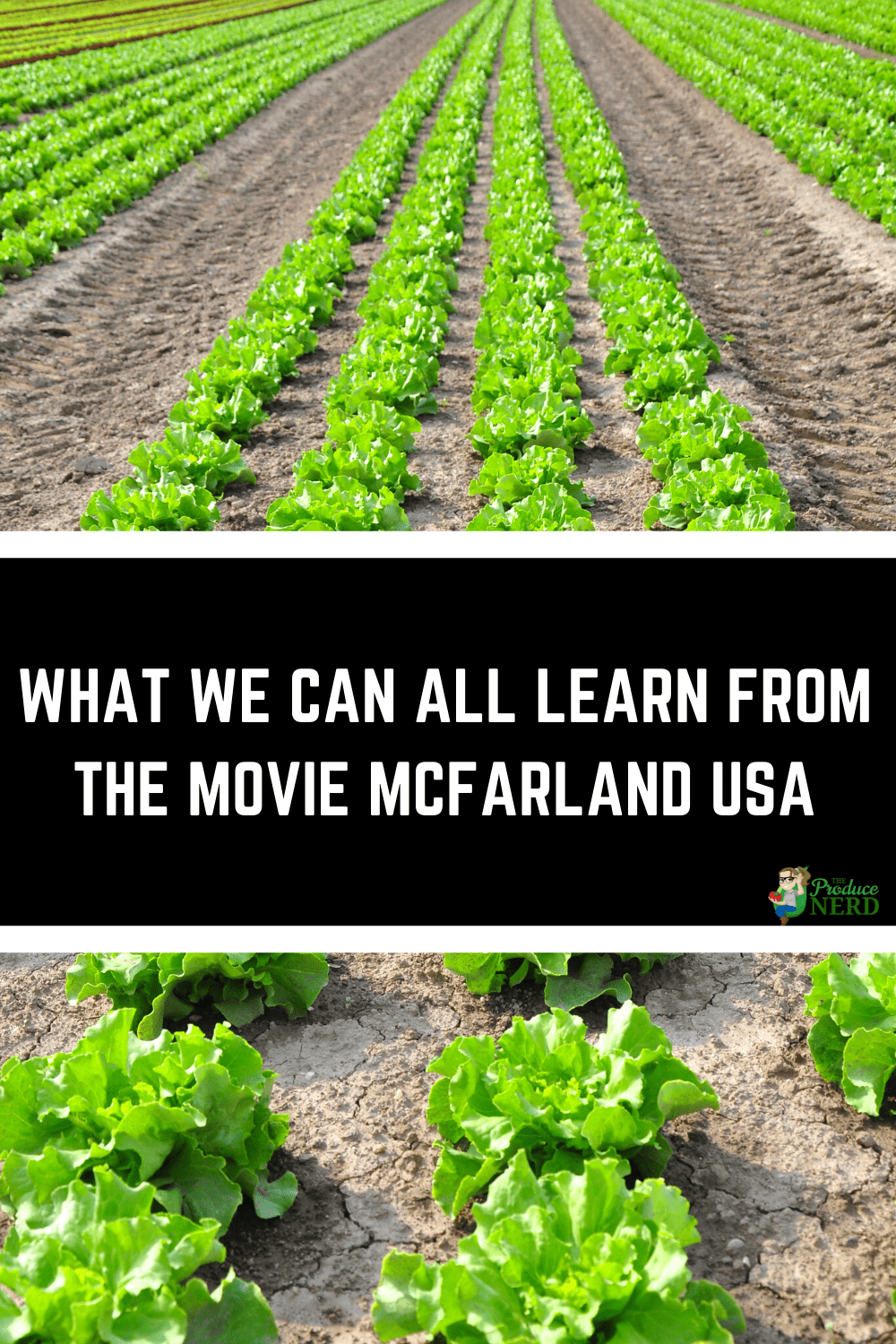California supplies more produce than any other state in the country. A lot of the agriculture that takes place in California is located throughout the Central Valley. In those small towns, many of which are still underdeveloped, there exists a thriving agriculture business. The field and facility workers might not demonstrate the wealth of their work, but they work harder than anyone I have ever seen. I think that is something that we, as a society, very often take for granted. The movie McFarland USA helps demonstrate the amount of work that it takes to be an agricultural worker, as well as the perseverance of the human spirit.
In the movie McFarland USA, which is based on the true story of a white man, Mr. White, who moved his family from the Midwest to McFarland, California (a small town near Bakersfield). McFarland consists of a large Latino population, filled with families who work in the fields, and Mr. White’s family has to deal with the cultural differences between themselves and the rest of the people living in McFarland. Mr. White overcomes these obstacles and forms a successful track team, and as a result, many lives are changed in a positive way, including those of Mr. White and his family.
Here are just a few of the things that we can learn from this movie that are still relevant today:
Table of Contents
The Power of Accepting Cultural Differences
People will always be able to separate themselves from others. In the movie, the town of McFarland is separated by both race and social class. For example, the students in the movie mainly consist of Mexicans, whose parents are field workers. Not only do they exhibit resistance toward the new white, “gringo,” coach, but they also feel as though he cannot relate due to his lack of understanding related to how their families live and work. However, throughout the movie, you can see the tolerance build between the two when the coach eats dinner at the Diaz’s house, helps pick in the field (which had to have been the greatest scene in the movie) and incorporates the team into his family’s events. That, plus the earned trust, between the two showed how tolerance and acceptance can be built between different people, and ultimately lead to appreciation for the differences and what they can introduce to each others lives. It is not always easy, but that does not mean it is impossible.
What it Takes to Work in the Field
Ever since the first harvesting field I walked onto, I have been amazed at how hard the harvesters work. We, as end users, might look at our food and sometimes remember to appreciate all of the work that was put into getting that piece of produce to us, but we will never understand the backbreaking work that goes into working in the field if we have not experienced it ourselves, as Mr. White does in the movie.
Some crops are more difficult than others, but there are some where I really worry whether the workers will be able to stand by the time they are 40 years old. My favorite part of the movie was when the coach went to work in the field, harvesting lettuce, with the Diaz family. This scene really showed how easy it is for bystanders to judge the amount of work because the coach started out with a good attitude that quickly dwindled, and ultimately led to him having to lay down and have one of the boy’s crack his back because his back was in so much pain. The team member described it as though his body were going into shock trying to adjust to the work, and that he will get used to it.
Not only is the work physically demanding, but it is very time consuming. The hours are long, and are even longer during the summer months when the sun is up longer. Harvesting starts early in the morning for most crops to “beat the heat.” In the movie, the Diaz brothers would wake up at 4am to go work in the fields and would also work there on the weekends. At one point, their parents would not let them be on the running team because the dad, who was a foreman, needed the boys to help work in the fields during practice times because he was getting paid by the field, so the faster the field was harvested, the more money he would make. The example given in the movie was that of a foreman. However, in terms of harvesters, they either work with a harvest crew and get paid hourly, or they work piece-rate, where they are paid by the amount that they individually harvest (a common practice in strawberry harvesting during peak season).
The Job Uncertainty Agricultural Workers Face
The fact is that a lot of field work is seasonal. So, what does that mean for workers when their crop is out season? If there are other crops being grown in their area, they can attempt to get work there. If not, they have to look elsewhere for work. As was very briefly mentioned in the movie, the workers will look for other work elsewhere in California, or in Arizona, or even as far as Texas. So the workers will leave their families to continue making a living, and come back when the season returns. I covered this in a recent post when describing how some agricultural workers work in the Salinas Valley with leafy green crops for a portion of the year, and then spend the rest of the year working on those same crops in Yuma, Arizona.
The Misunderstanding Toward Agricultural Workers
There is a common misunderstanding that agricultural workers do not know English and do not immerse themselves into the “American” culture. This was also brought up in the movie when the coach went to eat dinner at the Diaz’s house, and he attempted to speak to their father through the sons, assuming he did not know English. However, their father knew English, as did many of the other parents represented in the movie. It is true that there are some field workers who do not know English that well, but there are a lot of workers that do know English. Also, a notable moment at the end of the movie was when the teammates and their parents were at the big race, and all of the Mexican parents sang along to the Star – Spangled Banner.
What Agricultural Towns in California Consist Of
Although the movie is set in 1987, the movie was filmed in 2014, mainly in McFarland, CA. However, the situation depicted in McFarland USA is still relevant today. The houses, small corner stores, living conditions and even the stray dogs roaming the streets can all be seen today in most small, agricultural towns in the Central Valley.
Your Past/Present Does Not Determine Your Future
I am sure all of us can relate to this idea at some point or another. All of the running team consisted of people whose parents had not finished high school, and all seven of the highlighted team went on to attend college. That is pretty phenomenal! Even though they had to continuously prove themselves and work harder than everyone else, the coach helped show them that their past and current conditions did not have to determine their future. However, it is important to remember another life lesson explained in the movie, that although education, and the wealth and social status that can come with it is uplifting, it is not the key to happiness. In the movie, the parents of the successful track team students were always thankful for the little they did have, and they were happy with less because they valued family and love above all else.
The Power One Person Has to Change the World
This is such a powerful idea, and something that I think of often. Changing the world does not have to be on a large scale, but the coach depicted in the movie had such a great impact on the lives of the team members by believing in them and by pushing them to reach greatness. One of the other teachers went to the coach and read them the work of one of the team members that said that by running, he no longer felt as though he were defined as an “immigrant” or “stupid Mexican.” Those students that he empowered went on to do better things with their lives than what they ever thought possible. That is not only a good coach, but a good human being. This movie was really such a great reminder that it is not about what the world can do for you, but what you can do for the world.
Current Update on the Students of McFarland USA
Although this movie was based on a true story, there are a few differences. In the movie, the Diaz brothers make up three of the seven team members, and the video below (from KGET TV-17) tells the story of their and the rest of their family’s lives. It is pretty incredible to see the resilience of the human spirit.
When I was performing food safety audits and going to a different produce operation every day, I often asked the workers if they had seen the movie and what they thought and the resounding answer, is that the people who work in agriculture really enjoyed the movie. However, it was not made for agricultural workers, it was made for the general public because it is a touching, family story from which we can all learn something.
As I am sure you can imagine that if you have not yet seen McFarland USA, I highly recommend it!
Also, for all of the teachers that are using this as a teaching tool, you can see additional videos depicting different harvesting practices in the produce industry that are current today at The Produce Nerd’s YouTube channel, and you can also download a free lesson plan below!
If you enjoyed this post, you might also like:


I do deliveries around the South San Joaquin Valley and I see a lot of truth to what you have written here.